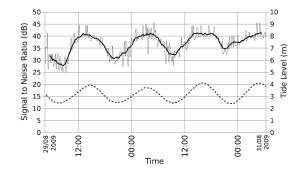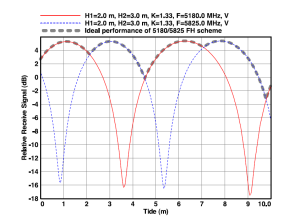Signal fading is a common issue among links installed over seas and in rainy locations. Due to tidal fading, links are constantly undergoing signal decrease and increase cycles. These events—arbitrarily defined as having fades relative to free space powers in excess of 20dB for a duration of 2 hours or more—are believed to be generally due to extreme subrefractive conditions.
Figure 1. The impact of the tidal fading effect on signal strength [1]
Analysis of synoptic weather conditions and nearby rawinsonde data [1] during four sustained deep fading periods showed atmospheric conditions consistent with extreme subrefraction. A tidal fading effect-based mechanism derived from the research conducted in [2] was therefore constructed.
Figure 2. The effect under the mitigated tidal fading mechanism [2]
The first prototype of the mitigated tidal fading effect mechanism was implemented starting from x.95 firmware, which helps to keep constant signal strength over sustained periods of time by using the slow frequency hopping approach. The frequency that is used by the algorithm is left for the user to choose. The only requirement is to select at least 2 frequencies, preferably with a gap no less than 100MHz between each instance. The signal level threshold must be selected based on the current link conditions.
—
[1] Fade statistics and propagation events at C band for two overwater, line-of-sight propagation paths over a 1-year period – Julius Goldhirsh, G. Daniel Dockery, Bert H. Musiani.
[2] Slow Frequency Hopping for Mitigating Tidal Fading on Rural Long Distance Over-Water Wireless Links – Alex Macmillan, Mahesh K. Marina, and Jhair Tocancipa Triana


